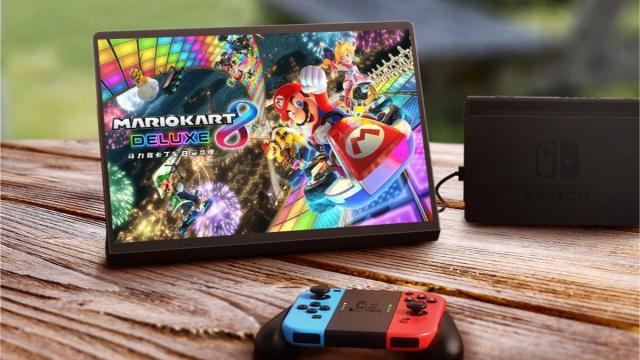Last week, Lenovo shared a photo on its Weibo social media page showing a tablet propped up on the company’s signature built-in kickstand. Behind it, a Nintendo Switch is shown plugged in to the tablet and using it as a monitor. Rumour has it Lenovo is working on such an Android tablet with a dedicated HDMI input, which is curious, especially with the Google I/O developers conference on the horizon.
An Android tablet that doubles as a portable entertainment hub with a second-screen experience may sound underwhelming, but with all this tablet talk lately and the iPad Pro with brand new M1 chip arriving in people’s hands, it’s time to start thinking about where Android tablets can go from here. They’ve been unsuccessful in competing at the high-end level with Apple, and it’s becoming more apparent that maybe a premium Android tablet is not what people really want.
It’s OK to Be Cheap
As it stands, Android tablets are an incredibly polarising device category. Few manufacturers make high-end Android tablets that can compete with Apple’s iPad Pro or the Microsoft Surface, choosing instead to target the low- to mid-range price point. Amazon showed that this strategy works with its vast lineup of Fire tablets, which run a reskinned, forked version of Android. Those tablets continue to sell because they’re accessible to anyone, and they’re also portals into Amazon’s content library, which many people default to with their Prime account.
Walmart tried to piggyback off this with its house tablet brand, called Onn. But the company stuck bloatware on there to push its Walmart+ content, which didn’t help its sales numbers. So Google stepped in. If you’ve been using Google devices, you may have noticed the company’s renewed focus on its content engine. Google’s revamped Entertainment Space interface for Walmart’s tablets helps shift the focus to these Android devices as vessels into the Play Store’s content ecosystem. Entertainment Space keeps the experience familiar across Google devices, too, since it shares a layout similar to Google TV. Once the Walmart Onn tablets receive the new update, they’ll become little content portals, akin to the Fire tablets.
On most affordable Android tablets, the screens are the marquee on the spec sheet, with other hardware hovering in the “just barely capable” zone. I’m speaking from experience here, as I’m currently using a Lenovo SmartTab M10 HD, which you can find at Walmart in the U.S. for about $170. I turned the tablet into a device for my toddler to tap around, but with 2GB of RAM, it’s so slow that all I ever really use it for is PBS Kids to keep her entertained, as well as the occasional reading of an ebook. That’s what these sub-$200 tablets are made to do.
It’s Still About Choice

Whereas Apple’s play has been to deliver a premium tablet experience across its lineup, Google’s has been to guide its users towards what available and what works for them. In the past, that’s felt a little like navigating the Wild West. But as Google reigned in Android’s source code, there’s been much more parity across the board.
That’s one reason why there are so many Android tablets and even new form factors coming to the category. In particular, a Google I/O 2021 session is scheduled to teach developers how to scale apps for various screen sizes beyond smartphones, including “the growing number of foldables, tablets, and desktop environments that exist today.” This means Android apps that look and work how they’re supposed to, whether you’re on a discount tablet, a foldout device like the Galaxy Z Fold 2, or even a 15-inch Chromebook with Android app capability.
This brings us back to the Lenovo images circulating on Weibo, as it’s an example of the many kinds of form factors available in Android land. The company shared other images of the Mario Kart-playing, Switch-connected tablet. One teaser photo shows the Lenovo device hanging in the kitchen with video instructions on how to cook, while another shows it lying on a desk with a stylus nearby.

My translated understanding of the leak suggests this is the Yoga Pad Pro and Pad Plus, marketed as devices that can hang anywhere with the flexible kickstand, play games with its HDMI-in support, and take notes with its pressure-sensitive stylus. Lenovo followed up by teasing a May 24 launch date for the devices.
Unfortunately, we probably won’t see them outside of China, but I’m intrigued — and a little jealous. The idea of an Android tablet with HDMI is especially befitting of the platform. It’s a full-functioning tablet that’s handy as a second screen and can perform double duty across all sorts of situations. Imagine travelling again and having one of these Lenovo Yoga tablets with a kickstand in the bag ready to entertain.
Look, the iPad is still the bestselling tablet, but as different Android form factors emerge, the success of Android tablets as a whole may no longer be contingent on a manufacturer launching an “iPad killer.” Instead, Android could eat away at the iPad’s market share with a massive pile of variety — some devices so niche that you can’t help but laugh at the thought.
I also personally love the idea of an Android tablet with an HDMI port because it’s an absolute wild card — and that’s fine, because the whole point of all this is that you can buy what you want.
